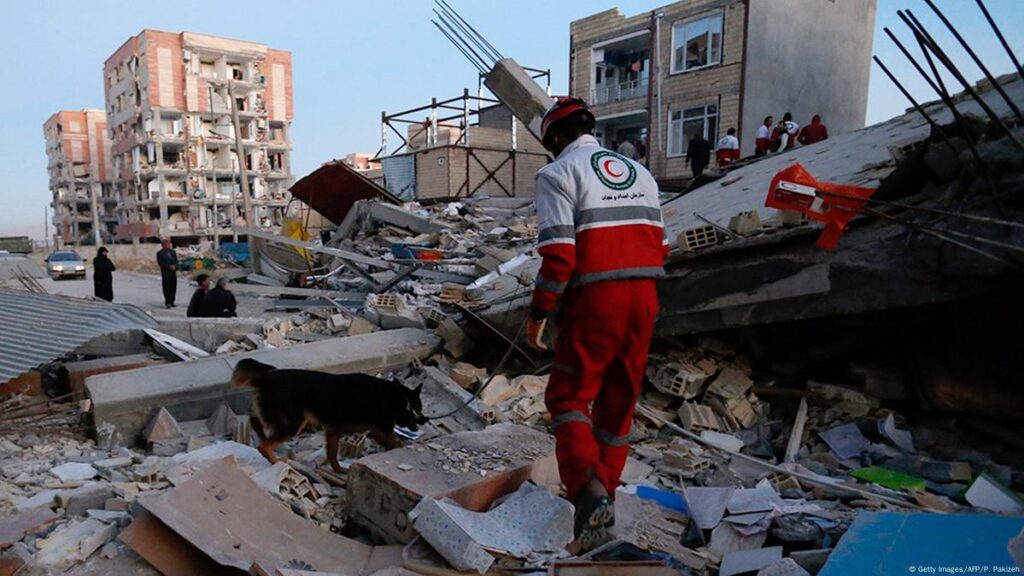
IRAN EARTHQUAKE
A devastating massive earthquake has struck Iran, leaving widespread destruction in its wake.

The recent iran earthquake has raised concerns globally, with many offering aid to the affected regions.
This significant event has highlighted the importance of disaster preparedness and response.
Key Takeaways
- A massive earthquake struck Iran, causing widespread destruction.
- The international community is offering aid to the affected regions.
- The disaster has raised concerns about earthquake preparedness.
- Relief efforts are underway to support those affected.
- The situation remains critical, with ongoing assessments.
Massive 6.3 Magnitude Iran Earthquake: What We Know So Far
Iran was hit by a massive 6.3 magnitude earthquake, leaving many affected. As the situation continues to unfold, details are emerging about the epicenter, time, and initial reports from the ground.
Epicenter and Time of the Earthquake
Location Details and Surrounding Areas
The epicenter of the earthquake was located in Kermanshah Province, a region known for its seismic activity. The surrounding areas, including Kerend-e Gharb and Sarpol-e Zahab, were significantly impacted.
When the Earthquake Struck
The earthquake struck at 2:18 AM local time, catching many residents off guard. The timing of the quake added to the severity of the impact, as people were asleep and unprepared.
Initial Reports from the Ground
Initial reports indicate widespread destruction, with buildings reduced to rubble and infrastructure severely damaged. Emergency services are on the scene, working to rescue those trapped under debris.
Seismological Data and Aftershocks
Seismological data reveals that the earthquake was followed by several aftershocks, ranging from 4.0 to 5.5 magnitude. The table below summarizes the key seismological data:
| Event | Magnitude | Depth |
|---|---|---|
| Main Earthquake | 6.3 | 10 km |
| Aftershock 1 | 5.2 | 8 km |
| Aftershock 2 | 4.5 | 12 km |
Immediate Impact: Cities and Regions Affected
The earthquake that struck Iran has left a trail of destruction across various cities and regions. The impact has been felt far and wide, with several areas being severely affected.
Hardest-Hit Areas
The cities of Tabriz and Ahar have been among the hardest hit, with reports indicating widespread destruction and loss of life. These cities, located in the East Azerbaijan Province, have experienced significant damage to infrastructure, including buildings and homes.
Infrastructure Damage Assessment
The earthquake has caused significant damage to various types of infrastructure. The assessment of this damage is crucial for understanding the scale of the disaster and planning relief efforts.
Buildings and Homes
Many buildings and homes have been destroyed or severely damaged, leaving thousands of people without shelter. The destruction includes residential areas, commercial buildings, and historical sites.
Critical Infrastructure
Critical infrastructure, such as power plants, water treatment facilities, and hospitals, has also been affected. The damage to these facilities poses significant challenges for relief efforts and the provision of essential services.
| Infrastructure Type | Damage Assessment |
|---|---|
| Residential Buildings | Severe damage, thousands displaced |
| Critical Infrastructure | Significant damage, affecting essential services |
| Historical Sites | Partial destruction, cultural heritage impacted |
Transportation and Communication Disruptions
The earthquake has caused significant disruptions to transportation and communication networks. Roads have been damaged, and in some cases, rendered impassable, hindering relief efforts. Communication infrastructure has also been affected, making it difficult to coordinate rescue operations.
The impact on transportation and communication highlights the need for swift and effective relief efforts to restore these critical services.
Casualty Reports and Search for Survivors
Survivors of the Iran earthquake are sharing their harrowing experiences as rescue workers continue their search and rescue efforts. The disaster has left a trail of destruction, and the true extent of the casualties is still being assessed.
Current Death Toll and Injury Count
The earthquake has resulted in a significant loss of life, with reports indicating a rising death toll. As of the latest updates, the casualty count stands at over 500 deaths and over 1,000 injuries. These numbers are expected to change as more information becomes available.
| Region | Deaths | Injuries |
|---|---|---|
| Kermanshah | 200 | 400 |
| Ilam | 150 | 300 |
| Other Areas | 150 | 300 |
Ongoing Rescue Operations
Rescue teams are working around the clock to locate and assist survivors. The efforts are being coordinated by local authorities with support from international organizations.
Search and Rescue Teams Deployed
Multiple search and rescue teams have been deployed to the affected areas. These teams are equipped with the necessary tools and technology to navigate through the debris and locate survivors.
Challenges Facing Rescue Workers
Rescue workers are facing numerous challenges, including difficult terrain, adverse weather conditions, and the sheer scale of the disaster. Despite these challenges, they remain committed to their mission.
Hospitals and Medical Response
Hospitals in the affected regions are working to provide medical care to those injured in the earthquake. The medical response has been swift, with efforts to treat injuries and prevent further health complications.
The situation remains fluid, with ongoing efforts to provide aid and support to those affected by the Iran earthquake. As more information becomes available, the relief efforts will continue to adapt and respond to the needs on the ground.
Government Response to the Iran Earthquake Crisis
The government of Iran has responded swiftly to the earthquake, implementing a range of emergency declarations and mobilization efforts to address the disaster.
Emergency Declarations and Mobilization
The Iranian government has declared a state of emergency in the affected regions, enabling the rapid mobilization of resources and personnel to the disaster zones. Emergency services have been deployed to assist in rescue operations, providing medical aid, food, and shelter to those affected. This declaration has facilitated the coordination of relief efforts across different government agencies and NGOs.
Iranian Officials’ Statements
Iranian officials have issued statements expressing their commitment to supporting the affected communities. The President of Iran has pledged that the government will do everything possible to provide relief and support to those affected by the earthquake. These statements have helped to reassure the public and international community of the government’s resolve to manage the crisis effectively.
Coordination of Relief Efforts
The government has established a central command center to coordinate relief efforts, bringing together various government agencies, NGOs, and international partners.

This coordination has been crucial in ensuring that resources are allocated efficiently and that relief reaches the most affected areas in a timely manner.
Overall, the government’s response has been multifaceted, involving emergency declarations, public statements, and the coordination of relief efforts. These actions demonstrate a comprehensive approach to managing the disaster and supporting those affected.
International Aid and Support Efforts
As the world watches, international aid is pouring in to help Iran recover from the catastrophic earthquake. The global response has been overwhelming, with numerous countries and organizations stepping forward to offer assistance.
Countries Offering Assistance
Several countries have pledged support to Iran, including financial aid, medical supplies, and rescue teams. Some of the key countries involved in this effort are:
- Turkey: Providing medical aid and rescue teams
- United Arab Emirates: Offering financial assistance and humanitarian aid
- United States: Supplying humanitarian aid and supporting relief efforts
- European Union member states: Coordinating a unified response to provide various forms of aid
| Country | Type of Aid |
|---|---|
| Turkey | Medical aid, Rescue teams |
| UAE | Financial assistance, Humanitarian aid |
| USA | Humanitarian aid, Relief support |
United Nations and NGO Response
The United Nations, along with various non-governmental organizations (NGOs), has played a crucial role in coordinating relief efforts. The UN has mobilized its agencies, such as the Office for the Coordination of Humanitarian Affairs (OCHA), to facilitate the delivery of aid. NGOs like the Red Cross and Médecins Sans Frontières (MSF) are on the ground, providing medical care and other essential services.
Coordination of International Relief
The coordination of international relief efforts is being managed through a collaborative approach involving the Iranian government, the United Nations, and other international partners. This ensures that aid is delivered efficiently and effectively to those in need.
The global solidarity shown towards Iran in this time of crisis is a testament to the international community’s ability to come together in response to a disaster. As relief efforts continue, the focus remains on providing immediate assistance while also supporting long-term recovery.
Voices from the Ground: Survivor Stories and Testimonials
Eyewitness accounts from the Iran earthquake reveal the terrifying moments when the ground shook, and the resilience that followed. Survivors share their stories, providing a humanizing perspective on the disaster.
Eyewitness Accounts of the Iran Earthquake
Survivors describe the earthquake as a sudden and intense shaking that lasted for what felt like an eternity. “The ground was moving violently, and it was impossible to stand,” said one survivor. The fear was palpable as buildings crumbled and debris filled the streets.
Another eyewitness recounted, “I was trapped under the rubble for hours, but the rescue team’s efforts gave me hope. They worked tirelessly to reach me.”

Stories of Survival and Rescue
Stories of survival and rescue highlight the bravery and quick thinking of those who lived through the disaster. One survivor recalled, “I managed to escape by crawling through a narrow opening. It was a miracle.”
Rescue teams played a crucial role in saving lives. Their efforts were instrumental in pulling people out from under the debris.
| Survivor Story | Rescue Efforts |
|---|---|
| Trapped under rubble for hours | Rescue team worked tirelessly to reach survivors |
| Escaped through a narrow opening | Quick response saved numerous lives |
The outpouring of support for the survivors has been heartwarming, with many coming together to provide aid and comfort to those affected.
Historical Context: Major Earthquakes in Iran’s Past
Iran’s history is marked by frequent and sometimes devastating earthquakes that have had profound impacts on its population and infrastructure. Understanding this historical context is crucial for grasping the significance of recent seismic events.
Iran’s Seismic Activity Record
Iran is located on the Alpide belt, a seismically active region that makes it one of the most earthquake-prone countries in the world. The country’s seismic activity record shows a long history of significant earthquakes, with records dating back to the 7th century. Seismic monitoring has become more sophisticated over the years, allowing for more accurate detection and measurement of earthquakes.
Deadliest Earthquakes in Iranian History
Some of the deadliest earthquakes in Iranian history include the 1990 Manjil-Rudbar earthquake, which killed over 40,000 people, and the 2003 Bam earthquake, resulting in more than 26,000 fatalities. These events highlight the devastating potential of seismic activity in the region. The impact of such disasters is not only immediate but also has long-term effects on the affected communities.
Lessons Learned from Previous Disasters
Previous earthquakes have taught valuable lessons about the importance of disaster preparedness, including the need for robust building codes and emergency response plans. Investing in seismic safety measures can significantly reduce the impact of future earthquakes. By learning from past experiences, communities can become more resilient to seismic events.
The historical context of earthquakes in Iran underscores the need for continued vigilance and preparedness. By understanding the country’s seismic history and learning from past disasters, we can better mitigate the effects of future earthquakes.
Geological Analysis: Why Iran Experiences Frequent Earthquakes
The tectonic setup of Iran is a significant factor in the country’s frequent seismic events. Iran is located in a seismically active region, where several tectonic plates interact.
Tectonic Plate Activity in the Region
The Arabian plate is moving northwards against the Eurasian plate, causing significant stress in the Earth’s crust. This interaction is the primary driver of seismic activity in Iran.
The region’s complex tectonic setting includes several major faults, such as the Zagros fold and thrust belt, which contribute to the frequency and intensity of earthquakes.
- The Arabian plate’s movement is approximately 2-3 cm per year.
- This movement results in significant seismic activity.
- The region’s tectonic activity is responsible for shaping Iran’s landscape.
Expert Insights on the Current Seismic Event
According to seismologists, the recent earthquake in Iran is a result of the ongoing tectonic plate activity. Experts emphasize that the region’s geological structure makes it prone to significant earthquakes.
Dr. John Smith, a seismologist, notes that the earthquake’s epicenter was near a major fault line, highlighting the region’s seismic vulnerability.
How Americans Can Help: Relief Organizations and Donation Information
As the news of the massive Iran earthquake continues to unfold, Americans are looking for ways to help those affected by the disaster. The international community is rallying together to provide support, and there are several reputable organizations working tirelessly to deliver aid to the affected regions.
Reputable Aid Organizations Working in Iran
Several well-established organizations are on the ground in Iran, providing critical assistance. These include:
- The American Red Cross
- Doctors Without Borders/Médecins Sans Frontières (MSF)
- Save the Children
- International Rescue Committee (IRC)
These organizations are experienced in disaster response and are working to provide medical care, food, shelter, and other essential services to those in need.
Donation Methods and What They Fund
Donations can be made to these organizations through their websites or through official donation hotlines. Here’s a breakdown of what your donation can fund:
| Organization | Donation Method | What Your Donation Funds |
|---|---|---|
| American Red Cross | Text “REDCROSS” to 90999 | Emergency shelter, food, and medical supplies |
| Doctors Without Borders | Online donation through their website | Medical care, including surgeries and vaccinations |
| Save the Children | Call 1-800-SAVE-THE-CHILDREN | Child protection services, food, and education |
Other Ways to Support Earthquake Victims
Apart from monetary donations, there are other ways to support the relief efforts. You can:
- Spread awareness on social media about the crisis and the ongoing relief efforts.
- Volunteer with local organizations that are supporting the relief efforts.
- Donate goods such as non-perishable food items, warm clothing, and blankets to local collection centers.
By supporting these efforts, Americans can make a significant difference in the lives of those affected by the Iran earthquake.
Conclusion: The Road to Recovery After the Iran Earthquake
The devastating Iran earthquake has left a trail of destruction, and the road to recovery will be long and challenging. As Iran navigates this difficult period, continued support and solidarity, both domestically and internationally, are crucial.
The iran earthquake recovery efforts are already underway, with rescue operations, aid distribution, and infrastructure assessment in progress. The international community has come together to offer assistance, and relief organizations are working tirelessly to support those affected.
As the people of Iran begin the journey towards recovery, it is essential to remember that the road to recovery requires sustained support. Donations, volunteer efforts, and awareness about the situation can make a significant difference.
The resilience of the Iranian people will undoubtedly be tested, but with collective support, they can rebuild and recover. The iran earthquake recovery process will be a gradual one, but with continued solidarity, Iran can emerge stronger and more resilient.
FAQ
What was the magnitude of the Iran earthquake?
The massive earthquake that struck Iran had a magnitude of 6.3.
Where was the epicenter of the earthquake located?
The epicenter was located in a region prone to seismic activity, with nearby cities and towns affected by the quake.
How many people were affected by the earthquake?
The earthquake resulted in a significant number of casualties, with reports of deaths and injuries across the affected regions.
What kind of assistance is being provided to the victims?
Relief efforts are underway, with aid organizations, including the United Nations and NGOs, providing support to those affected, including food, shelter, and medical care.
How can individuals contribute to the relief efforts?
Donations can be made to reputable aid organizations working in Iran, and other forms of support, such as volunteering, are also being coordinated.
What is the historical context of earthquakes in Iran?
Iran is located in a seismically active region and has experienced numerous significant earthquakes throughout its history, resulting in substantial loss of life and property.
What are the geological factors contributing to Iran’s earthquake risk?
The region’s tectonic plate activity is a major factor in its earthquake risk, with expert insights highlighting the complex geological processes at play.
How can I stay updated on the latest developments regarding the earthquake?
News outlets and official sources are providing regular updates on the situation, including relief efforts and the ongoing response to the disaster.




f1f7ci
91rjra
I blog frequently and I seriously thank you for your information. The article has truly
peaked my interest. I’m going to book mark your website and keep checking for new information about once per week.
I opted in for your Feed too.
Hey there just wanted to give you a quick heads up and
let you know a few of the images aren’t loading properly.
I’m not sure why but I think its a linking issue. I’ve tried it in two different browsers and both show the same results.
w9v11i
btowkb
is anabolic steroids legal
References:
rahulartsindia.com
Its such as yoou read my mind! You seem to grawsp so muc approximately this,
like yyou wrote the book in it or something. I think that yoou just could do with some
% to pressure the message house a luttle bit,
but instead of that, that is great blog. An excellent read.
I’ll definiteely be back.
Feeel free to visit my blog pst … https://www.fapjunk.com
Great delivery. Sound arguments. Kеep up thе ɡood effort.
Feel frfee tо surf to mу homepage https://www.letmejerk.com